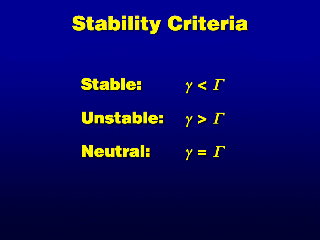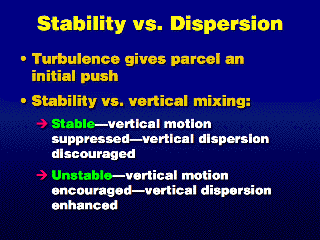 This summarizes the results of our stability tests on different values of
the environmental lapse rate. Note that we are characterizing the stability
of the atmosphere as a function of the environmental lapse rate. Air
parcels are not characterized by their stability (except when they happen
to be in a state of equilibrium); they are normally described as being postively/negatively/neutrally
buoyant; the vertical motions of these (bouyant) parcels will be affected
by whether the atmosphere is stable/unstable/neutral.
This summarizes the results of our stability tests on different values of
the environmental lapse rate. Note that we are characterizing the stability
of the atmosphere as a function of the environmental lapse rate. Air
parcels are not characterized by their stability (except when they happen
to be in a state of equilibrium); they are normally described as being postively/negatively/neutrally
buoyant; the vertical motions of these (bouyant) parcels will be affected
by whether the atmosphere is stable/unstable/neutral.
 Vertical dispersion of pollutants is controlled by the stability of the atmosphere.
The greater the vertical movement or convective dispersion
of the polluted air parcels, as in an unstable environment, the lower the pollution
concentration (more dispersion = lower concentration). This applies directly
to pollution sources at the ground that mix upward, but we'll see later that
in the case of chimney plume dispersion, it's better to have the smallest
amount of convective dispersion to get the lowest pollution concentration at
the ground!
Vertical dispersion of pollutants is controlled by the stability of the atmosphere.
The greater the vertical movement or convective dispersion
of the polluted air parcels, as in an unstable environment, the lower the pollution
concentration (more dispersion = lower concentration). This applies directly
to pollution sources at the ground that mix upward, but we'll see later that
in the case of chimney plume dispersion, it's better to have the smallest
amount of convective dispersion to get the lowest pollution concentration at
the ground!
In the computer lab simulation of air parcel motion, we will see that positively
buoyant (i.e., hot) air parcels rise within a stable atmosphere, but because
the the atmosphere's stability tends to resist vertical motion, these parcels
will probably stop rising at some point. If the atmosphere is unstable, these
parcels will keep rising forever (actually, only up to the base of the stratosphere).
On top of all this is molecular diffusion, and to a lesser extent, turbulence,
even for stable air. These processes are much slower than convection to
disperse pollutants, so we usually consider tham as afterthoughts.
Advective dispersion is not affected by stability,
since horizontal winds are not subject to the buoyancy forces that drives convection.
The degree of advective dispersion depends on the wind speed---the greater the
wind speed, the greater the horizontal dispersion and the lower the concentration
of pollution.


 This summarizes the results of our stability tests on different values of
the environmental lapse rate. Note that we are characterizing the stability
of the atmosphere as a function of the environmental lapse rate. Air
parcels are not characterized by their stability (except when they happen
to be in a state of equilibrium); they are normally described as being postively/negatively/neutrally
buoyant; the vertical motions of these (bouyant) parcels will be affected
by whether the atmosphere is stable/unstable/neutral.
This summarizes the results of our stability tests on different values of
the environmental lapse rate. Note that we are characterizing the stability
of the atmosphere as a function of the environmental lapse rate. Air
parcels are not characterized by their stability (except when they happen
to be in a state of equilibrium); they are normally described as being postively/negatively/neutrally
buoyant; the vertical motions of these (bouyant) parcels will be affected
by whether the atmosphere is stable/unstable/neutral. Vertical dispersion of pollutants is controlled by the stability of the atmosphere.
The greater the vertical movement or
Vertical dispersion of pollutants is controlled by the stability of the atmosphere.
The greater the vertical movement or